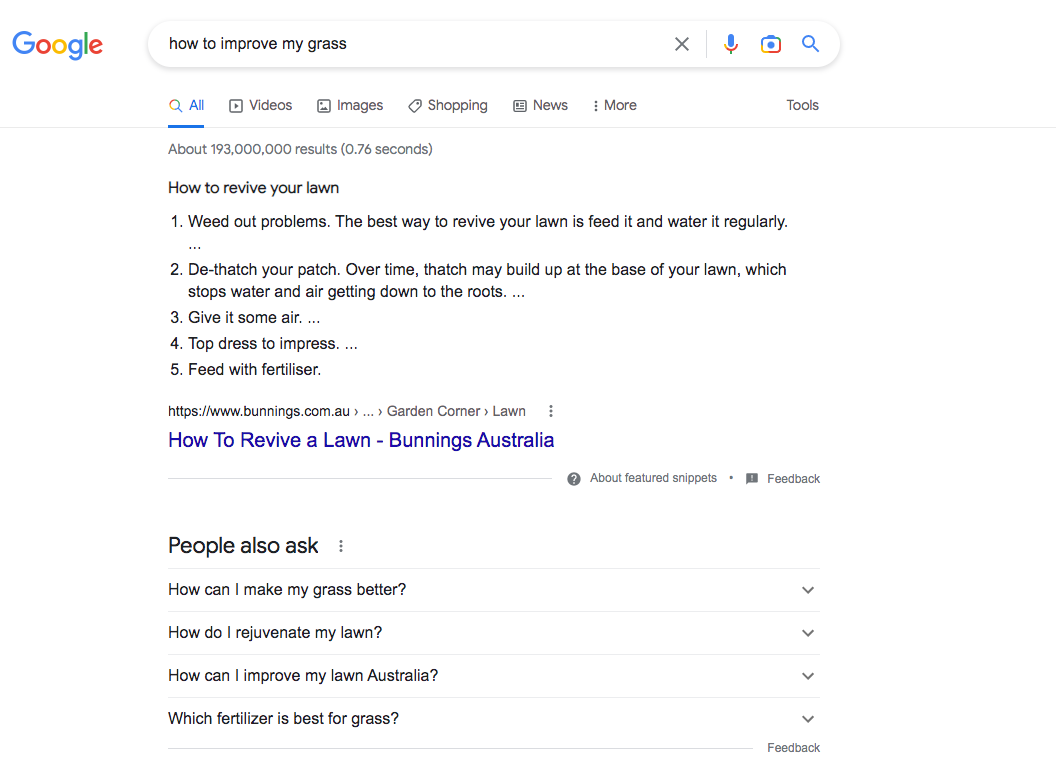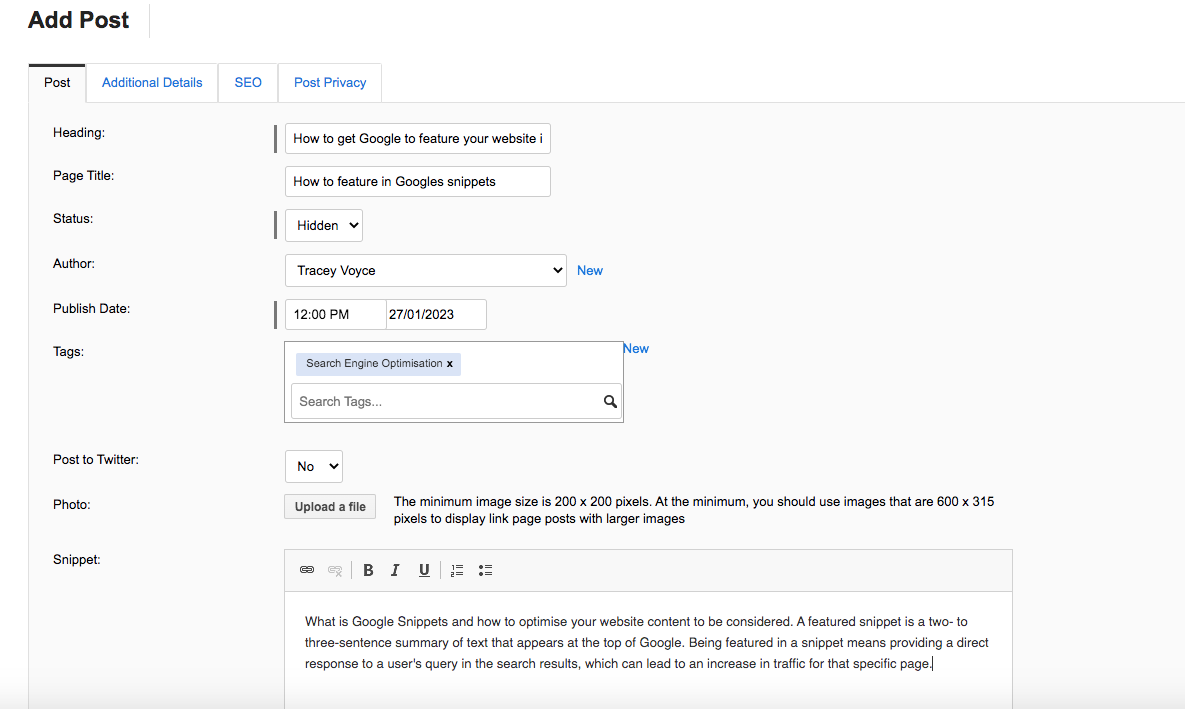How to get your website to appear in Google's featured snippets?
)
The featured snippet is a highly sought-after position in the search engine results pages (SERPs). It allows a website to quickly rise to the top of the search results, even if its "traditional" ranking would place it lower on the first page.
What is a featured snippet?
A featured snippet is a short summary of text, usually two to three sentences, that appears at the top of Google's search results. It directly answers the user's query and can result in increased traffic for the featured page.

To optimise for featured snippets, we recommend the following steps:
Include a "What is" heading
Use a sentence structure that starts with "is"
Clearly define the topic
Follow the format of existing featured snippets
Avoid using your brand name
Avoid using first-person language
Optimise for multiple featured snippets
Prioritise pages that already rank in the top five
Continuously improve your optimisations
Use some of the Bloomtools features in the back end to further enhance your success:

It's important to note that the featured snippet algorithm is simpler than Google's primary algorithm and is more heavily influenced by on-page adjustments that clearly define the topic to users.
Another important aspect of featured snippet optimisation is considering how it will be used in voice search. Google reads back featured snippets when users perform voice queries on mobile devices or Google Home. Therefore, it's crucial to ensure that the featured snippet makes sense in this context and to consider how it would sound if read aloud.
Types of featured snippets in Google:
Paragraph featured snippets:
These are the most common type of featured snippets, and they display a block of text that directly answers the user's query.List featured snippets:
These types of featured snippets display a list of items or steps that answer the user's query. They are often used for queries that have a numerical or step-by-step answer.Table featured snippets:
These featured snippets display a table that answers the user's query. They are often used for queries that have a lot of data or comparison information.Video featured snippets:
These featured snippets display a video that answers the user's query. They are often used for queries that have a lot of visual information or for queries that benefit from a step-by-step explanation in a video format.Audio featured snippets:
These featured snippets display an audio clip that answers the user's query. They are often used for queries that have a lot of pronunciation or enunciation information.Knowledge Graph featured snippets:
These featured snippets display a box that contains information about a specific topic or entity. They are often used for queries that are asking for specific information about a person, place, or thing.
It's important to note that Google is constantly experimenting and updating the types of featured snippets, so it's possible that new types will be introduced in the future.
How to optimise for Google's featured snippets?
Optimising for Google's featured snippets can help increase visibility and drive more traffic to your website. Featured snippets are the answers that appear at the top of the search results page, providing users with quick and concise information about their query. Here are some tips to help you optimise your content for featured snippets:
1. Add a 'What is' heading
To start your featured snippet optimisations, you'll want to look for a place in your content to add a "What is [keyword]" heading tag. This signals to Google that your upcoming text could be helpful as a featured snippet.
Countless examples of pages get the featured snippet using this heading format. We've seen good success rates when replicating this strategy for our clients.
Ideally, you'll add this heading as close to the top of your content as possible. If writing a blog post, I'll generally add it right below the introductory paragraph. This is often a great place to add it because it flows well with the content while allowing you to include it near the top of the page.
2. Use the 'is' sentence structure
When optimising for the featured snippet, it's important to include an "is" statement. The first sentence should start with the structure: "[Keyword] is…"
Below are some examples from results getting the featured snippet:
- "EBIT data is Earnings before interest and taxes (EBIT) is a common measure of a company's operating profitability. As ... "
- "Email Marketing software is an online tool that enables users to create, send, and track emails to their list of subscribers. Using software makes it easier to create well-designed emails, and also allows you to see key metrics such as open rates and click-through rates."
- "Return on Investment (ROI) is a performance measure used to evaluate the efficiency of an investment or compare the efficiency of a number of different investments."
To boost your chances of getting the featured snippet spot, ensure that your first sentence follows this format. By using an "is" statement, you should see a higher percentage of your optimisations result in winning the featured snippet.
3. Fully define the topic in 2-3 sentences
This is the most important rule to follow.
Featured snippets should give users as much information about the topic as quickly as possible.
This means the content you're optimising must try to describe the topic as completely as possible in two to three sentences. For this rule, being concise is extremely important.
Here are some general guidelines we try to follow when trying to concisely define featured snippets
- The first sentence should define the topic.
- The second and third sentences should describe 2-3 must-know facts about the topic.
- Avoid using any extraneous phrasing in your definition.
- Match the featured snippet format
- As explained earlier, the different types of featured snippets include:
- Paragraphs (most common).
- Bulleted and numbered lists.
- Tables (least common).
This rule is simple. Whatever featured snippet type you see on the SERP, match that type in your content.
For example, if you see a paragraph featured snippet appearing for the term you want to optimise for, you need to find a place to add/adjust two or three sentences of text.
However, if a bulleted list appears, you'll need to add a similar list to your page's content.
4. Never use your brand name in featured snippet text
This is a popular mistake.
A company will get rules 1-4 right but will use some language that makes the result ineligible for the featured snippet. Brand names are one example of such language.
Remember that featured snippets fuel voice search. Devices such as Google Home will directly gain featured snippets and enhance your SERP visibility
With these tips, you'll be well-equipped to optimise for featured snippets.
It's crucial to:
- Use a statement beginning with "is"
- Clearly outline the subject in a couple of sentences.
By adhering to the above guidelines, you should see a substantial increase in the number of featured snippets your website earns. If you would like some assistance to improve your rankings on Google, contact one of our team to run an analysis on your website to give you direction on what you need to do to improve your results.
) Author:Tracey Voyce
Author:Tracey Voyce| Tags:Search Engine Optimisation |
Check Out Our
Recent Articles
- The 2026 Visibility Playbook: How to be Findable, Believable, and Easy t...
- Get Rewarded: How to Double Your Reach by Nailing Social Media Interacti...
- Google’s December 2025 Core Update: What It Means for Your Business
- Your Brand Doesn’t Start With Your Logo - It Starts Inside Your Business
- 2025: The Year AI Search Decides Which Businesses Get Found (and Which D...



